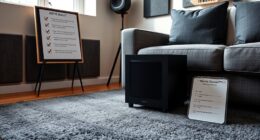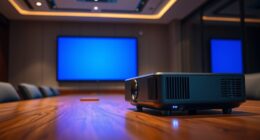To fix keyboard and controller lag, first make certain your wireless devices have a clear line of sight and use low-latency peripherals designed for gaming. Consider switching to wired options or upgrading to gaming-focused wireless peripherals. Keep your firmware updated and reposition wireless receivers closer to your devices. Optimize your system by updating drivers and setting it to high-performance mode. For more detailed tips, explore additional ways to improve responsiveness and reduce lag.
Key Takeaways
- Use wired peripherals or low-latency wireless devices with a clear line of sight for reduced input delay.
- Keep wireless devices close to the receiver and use USB extension cables to improve signal stability.
- Update device firmware regularly and ensure proper pairing to prevent lag caused by connectivity issues.
- Upgrade to newer peripherals with high polling rates and low latency features for better responsiveness.
- Optimize system performance by updating drivers, enabling high-performance mode, and disabling unnecessary background processes.

Lag or delay between your input and on-screen response can ruin your gaming experience, but there are effective solutions to minimize keyboard and controller lag. One common culprit is wireless interference, which can disrupt signals between your device and its receiver, causing noticeable delays. To combat this, start by ensuring your gaming peripherals use high-quality, low-latency wireless technology. Devices that operate on a dedicated 2.4 GHz or Bluetooth connection tend to perform better than older or cheaper models that are prone to interference. Keep other wireless devices—like Wi-Fi routers, mobile phones, or cordless phones—away from your keyboard or controller’s receiver. This reduces the chance of signal disruptions and ensures a more stable connection.
Upgrading your hardware can also considerably reduce lag. If you’re still using outdated peripherals, consider investing in newer models with wired connections or low-latency wireless options. Wired keyboards and controllers typically have less lag because they don’t rely on wireless signals that can be affected by interference. If you prefer wireless, opt for devices that boast low latency and are designed specifically for gaming. Many gaming peripherals now come with features like plug-and-play setups, high polling rates, and optimized firmware that help minimize input delay.
Upgrade to wired or low-latency wireless peripherals for reduced input lag and better gaming performance.
Beyond the peripherals themselves, your computer’s hardware can influence input responsiveness. Upgrading your graphics card, processor, or ensuring you have sufficient RAM can improve overall system responsiveness, which in turn reduces lag. Keep your device drivers up to date, especially for your graphics card and input devices, as manufacturers often release updates that enhance performance and address latency issues. Additionally, optimizing your operating system for gaming—disabling unnecessary background processes, and setting your system to high-performance mode—can make a noticeable difference in input delay.
Another helpful tip is to check your connections and settings. Use high-quality, short USB cables for wired peripherals to minimize signal degradation. For wireless devices, ensure they are paired correctly and that their firmware is current. If you experience persistent lag, try repositioning your receiver closer to your peripherals, or even using USB extension cables to place the receiver in a more suitable spot. Regularly cleaning your device’s firmware and resetting connections can also alleviate latency issues caused by corrupted data or poor pairing. Additionally, paying attention to the quality of your projectors’ color accuracy can help optimize your overall gaming or media experience by ensuring consistent and vibrant visuals.
Frequently Asked Questions
Can Lag Be Caused by Internet Connection Issues?
Yes, your internet connection issues can cause lag. Wireless interference can disrupt your connection, leading to delays in data transmission that affect gameplay. Hardware incompatibility, such as outdated routers or network adapters, can also worsen lag by not supporting ideal speeds. You might notice input delays or lag spikes, especially during online gaming. To fix this, guarantee your internet connection is stable, minimize interference, and update your hardware for smoother gameplay.
Do Wireless Keyboards and Controllers Have Higher Latency?
Imagine a quiet room suddenly disrupted by a flickering light; that’s similar to how wireless interference affects your devices. Wireless keyboards and controllers often have higher latency because signal stability can fluctuate due to interference from other devices or obstacles. This can cause delays between your actions and their response on screen, making wired options more reliable for low-latency gaming experiences. Keep your wireless gear close and free of interference for better performance.
How Does Software Update Affect Input Lag?
Software updates, especially firmware updates, can reduce input lag by improving performance and fixing bugs. They guarantee your device’s hardware and drivers stay compatible, preventing lag caused by driver conflicts. However, sometimes updates introduce new issues or compatibility problems, which might temporarily increase input lag. Regularly updating your keyboard or controller’s firmware and drivers helps optimize responsiveness, but always check for reliable updates and read user feedback before installing.
Is There a Way to Test My Device’s Latency?
Yes, you can test your device’s latency by performing hardware diagnostics and device calibration. Use built-in tools or third-party software to measure input response times. Connect your keyboard or controller to a computer, then run tests that track the delay between your input and the device’s response. Regular calibration helps verify accurate readings, allowing you to identify and address any lag issues effectively.
Can Changing USB Ports Improve Controller Response Time?
Yes, changing USB ports can improve your controller response time. Try USB port optimization by switching to a different port, preferably a dedicated or USB 3.0 port for faster data transfer. Also, verify your controller firmware is up to date, as updates often fix latency issues. This combination can reduce lag, giving you a more responsive gaming experience. Remember to unplug and reconnect your controller after making these changes.
Conclusion
By tackling keyboard and controller lag, you’re clearing the path for smoother gameplay. Think of lag as a stubborn obstacle on your racing track—once removed, your progress speeds up effortlessly. Keep your devices optimized and stay updated to maintain that seamless connection. When you eliminate lag, you’re not just improving performance—you’re tuning your gaming experience, turning it into a finely tuned engine that propels you toward victory with precision and confidence.















